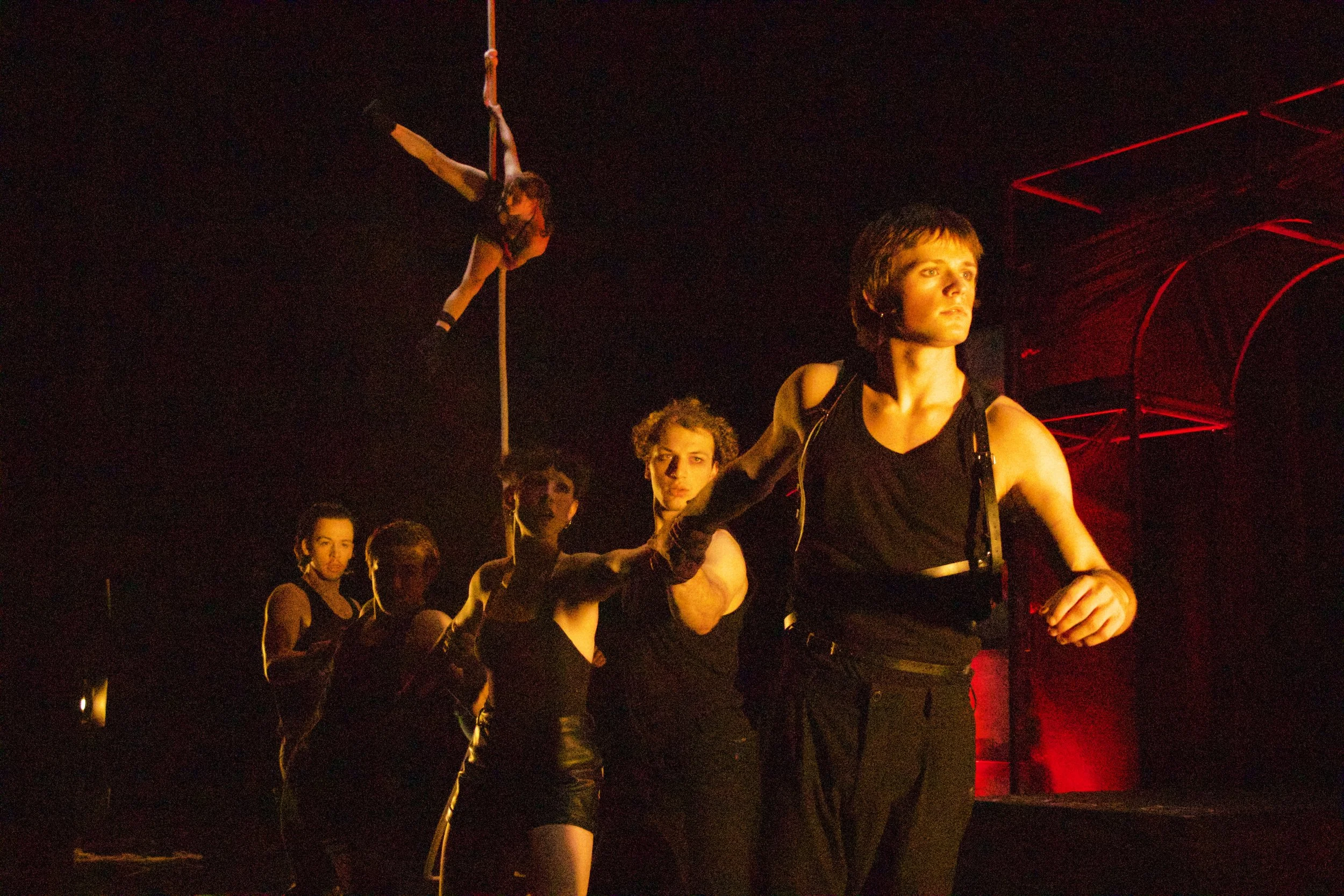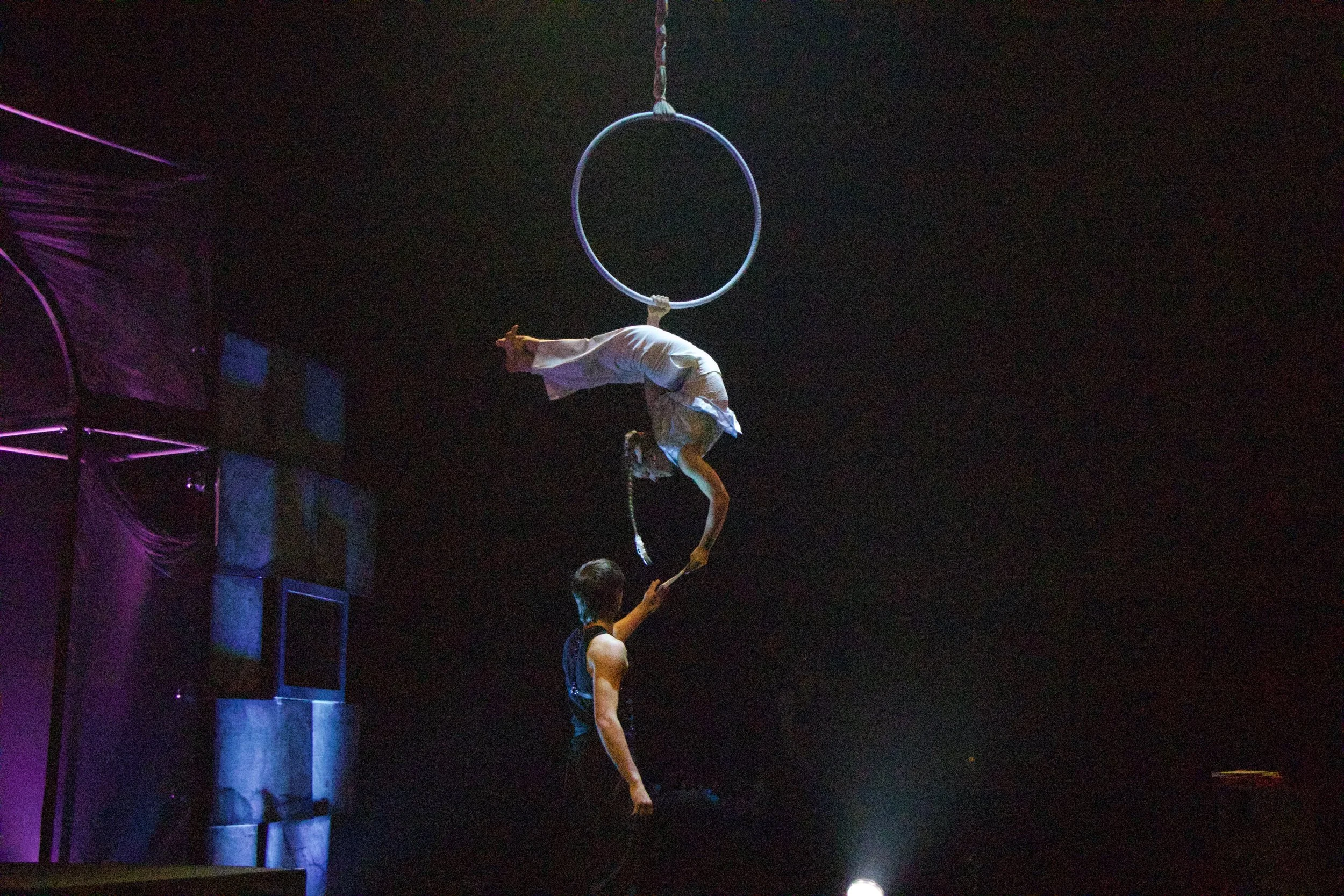The New York Circus Project Twists ‘Hamlet’ into an Acrobatic Extravaganza at Union Market
New York Circus Project
William Shakespeare’s taste for tragic tales of love and revenge has made his work immortal. Each play is a living document, malleable enough to accommodate the all-American tenderness of a Stephen Sondheim score or the absurdity of a Baz Luhrman blockbuster.
The New York Circus Project‘s HAMLET, a contemporary circus adaptation of the Shakespearean classic performed at Union Market Dock 5 in Washington, DC, this past month, took the flexibility of what is generally accepted as Shakespeare’s most successful story to a literal place, with several tricks up their sleeve
Actor Maddox Morfit-Tighe’s character in Hamlet sulks into 2024 with all the trappings of today’s angsty young man: smudged eyeliner, dangly earrings, and a choppy mullet to honor my generation’s archetypal alt boy, adored despite better judgment. Morfit-Tighe’s acting chops stand-alone, but his physical prowess aids him in accessing the full breadth of Hamlet’s moods. I didn’t realize it’s possible to do a backflip in a brooding way. Still, Morfit-Tighe pulls it off, his physicality adding a depth to the titular character that no previous retellings have had the means to contribute. Whether he’s fawning or fuming, Hamlet’s impulsivity and energy are his most consistent traits, and watching those feelings explode into acrobatic displays flung me into more catharsis than his iconic soliloquy alone ever has.
The New York Circus Project
Hamlet is the first theatrical performance to grace Union Market’s Dock 5, and the warehouse environment lends itself well to crowd engagement. It’s easier than ever to be drawn into Rosencrantz and Guildenstern’s (Asom Hayman-Jones and Glenn Doyle) antics as they chase Hamlet through mazes of viewer seating and perform hand-to-hand stunts so spirited that one fears they’ll come tumbling down onto the front row. The score is another effective effort to make the production feel personal, punctuated by familiar jazz standards in the styles of Nina Simone and Etta James and pulsating twenty-first-century beats from popstar Kim Petras.
None of the performers have microphones, which can make their conversations hard to hear, especially at Dock 5. But frankly, the show’s dialogue felt more like an afterthought than a central component. In future productions, the NYCP might consider cutting the speaking parts altogether. While the actors were talented, it often felt like their breath could be used more productively in additional stunts. The movement is what carried the audience’s collective attention.
This feat is proven most pointedly by Ilse Baryshnikov as Ophelia, who chronicles her character’s descent into despair through her dazzling contortions – introducing herself with sweeping, sophisticated gestures and leaving us with agonized, jerking maneuvers. There was truth to Baryshnikov’s illustration of female hysteria that possibly no other medium could have conveyed. How does NYCP convey Ophelia’s struggle against the trappings of traditional femininity and virginity? Well, they hang a writhing Baryshnikov from the ceiling by her long, blonde hair, of course – suspended in free-fall by a symbol of her girlishness, unable to touch the ground due to the unbearable weight of all the rest.
The New York Circus Project
With that said, it’s no surprise that Ophelia’s suicide is the most compelling scene of the show. The original play’s river is replaced by a small, shallow pool and Baryshnikov’s contortion routine brings the tension, her dexterity taking the power away from the water. Make no mistake: Ophelia is both the current and its victim, surely drowning herself. Baryshnikov’s active participation in her character’s death makes it even more sobering than our cultural conception of Ophelia, lying limp in the riverbed with flowers in her hair.
As naturally as Shakespeare’s plots can shapeshift, it’s not easy to reimagine his writings in a way that enriches their themes. But the sparkling young cast of NYCP’s Hamlet – whose memories of tedious high school popcorn reading sessions of the source material are likely not so distant – offer novelty without gimmick, moving the story into the present day like true Gen Z-ers through physical narrations rooted in innovation and anxiety. Whatever has rotted in Denmark, they’re reviving themselves.
The New York Circus Project’s “Hamlet,” directed by Sam Landa and choreographed by Landa and Danielle Diniz. Audiences can catch the tour’s next stop at the Studebaker Theater in Chicago. Running time is one hour and 40 minutes. For information on tickets in other cities, check out The New York Circus Project.
Cast and Stage: Claudius, played by Adebowalé Adebiyi; Gertrude, played by Hilary Dennis; Ghost of Hamlet’s Father, played by Ron Oppenheimer; Horatio, played by Samuel Kellar-Long; Laertes, played by Jacob Crow; Polonius/Ensemble played by Rachel Rees; Player/Ensemble played by Hannah Grove and Shea Baker; Scenic Design by Kristian Woerner; Costume Design by Lily Cunicelli; Lighting Design by Nate Files; Technical Direction by Kyle Driggs; Graphic Design by Sawyer Sadd; Associate Directing by Carolyn Friedman
Kate Corliss is a writer based in Washington, D.C. She graduated from American University in 2024 with a B.A. in Journalism.



